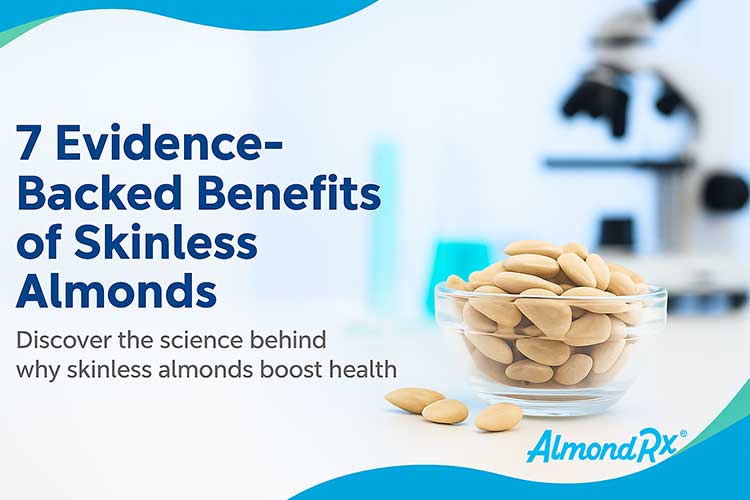
Introduction
When it comes to nutrient-dense snacks, almonds are often considered a superfood. But skinless almonds (also called blanched almonds) offer unique advantages compared to regular almonds with skin. By removing the brown outer layer, these almonds become easier to digest while still delivering powerful health benefits.
In this guide, we’ll explore 7 evidence-backed benefits of skinless almonds, plus tips on how to add them to your diet.

1. Easier Digestion & Better Nutrient Absorption
The almond skin contains tannins and phytic acid, which can reduce mineral absorption. Removing the skin allows your body to absorb more nutrients like calcium, magnesium, and iron.
Soaking skinless almonds overnight further enhances digestibility and nutrient uptake.
2. Rich Source of Plant-Based Protein
A single ounce (28g) of skinless almonds contains about 6 grams of protein, making them ideal for vegetarians, vegans, and fitness enthusiasts. This protein helps repair muscles, increase satiety, and maintain steady energy.
3. Gentle on Sensitive Stomachs
Some people experience bloating or discomfort from almond skins. Skinless almonds are softer, lighter, and gentler, making them suitable for:
- Kids
- Seniors
- People with digestive issues
4. Heart Health & Cholesterol Control
Skinless almonds are rich in monounsaturated fats, magnesium, and vitamin E. These nutrients help:
- Lower LDL (“bad”) cholesterol
- Reduce oxidative stress
- Support overall cardiovascular wellness
5. Skin Health & Anti-Aging Benefits
The vitamin E in blanched almonds protects skin cells from damage, improves elasticity, and supports collagen production. Regular consumption may reduce signs of aging and promote a natural glow.
6. Weight Management & Satiety
The combination of protein, healthy fats, and fiber (even without the skin) makes skinless almonds a high-satiety snack. They help reduce unnecessary snacking, stabilize blood sugar, and support healthy weight loss.
Snack idea: A handful of skinless almonds mid-morning keeps you full until lunch.
7. Versatility in Recipes & Snacks
Beyond health, blanched almonds are highly versatile:
- Blend into almond milk or smoothies
- Use in desserts like halwa, kheer, or marzipan
- Make almond butter
- Roast with herbs for a crunchy snack
Their smooth texture and mild flavor make them perfect for both sweet and savory dishes.
How to Add Skinless Almonds to Your Diet
- Eat 8–10 soaked almonds daily for brain and heart health
- Use powdered skinless almonds in baking
- Add them to smoothies for creaminess
- Mix into salads or yogurt bowls
Final Thoughts
From better digestion and nutrient absorption to skin health and weight control, the benefits of skinless almonds are backed by science. Whether you enjoy them soaked, roasted, or blended, blanched almonds are a delicious and versatile way to upgrade your nutrition.
Looking for the highest-quality skinless almonds? Explore our [AlmondRx Premium California Almonds].
FAQs on Skinless Almonds
Q1. Are skinless almonds as healthy as regular almonds?
Yes. While removing the skin reduces some antioxidants, the inner almond still provides protein, healthy fats, vitamins, and minerals.
Q2. Can skinless almonds help with weight loss?
Yes. Their high protein and fat content keeps you full longer, reducing unnecessary snacking.
Q3. Are skinless almonds good for kids?
Absolutely. They are softer, easier to chew, and easier to digest, making them great for children.
Q4. How many skinless almonds should I eat daily?
A handful (8–10 almonds) is ideal for most people, though active adults can consume more depending on calorie needs.
Q5. Can I use skinless almonds for almond milk?
Yes. In fact, skinless almonds make creamier almond milk without the grainy texture of almond skins.



